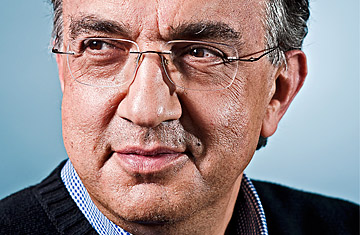
Sergio Marchionn at Chrysler headquarters in Auburn Hills, Mich.
(4 of 7)
If there's a prototype of a bicontinental auto executive, the binational, bilingual Marchionne, 59, might fit it. Born in Chieti, Italy, he moved to Toronto as a teenager and got business and law degrees in Canada. But he is also a jazz freak and has been known to rip around Fiat's test tracks at 150-plus m.p.h. (240-plus km/h). Marchionne began his career as an accountant for Deloitte & Touche in Toronto. By the time Fiat came calling in 2004, he was running Socit Gnral de Surveillance (SGS), a Swiss industrial-testing and monitoring firm whose specialty was establishing standards. But it was no ordinary call: SGS is the second largest investment of the Agnelli family, the powerful Italian dynasty that founded and still controls Fiat. After a dinner in Geneva and "too many grappas" with Fiat chairman John Elkann (grandson of Giovanni Agnelli), Marchionne agreed to the Fiat job.
Elkann admires Marchionne's ability to "manage friction"--and of that there was plenty. Fiat was even in worse shape than Chrysler, losing $5 million a day. Picture GM and Caterpillar combined in a company that builds everything from farm tractors to construction equipment to cars. Marchionne eventually divided the firm into two separate pieces: Fiat S.p.A. and Fiat Industrial. His analytical, accountant side--vital to a precision industry like auto manufacturing--could be conveniently ascribed to a Canadian coolness. But it can't restrain the passionate Italian with the sometime Vesuvian temper. ("You've got to be dyslexic in this industry," he explains.) He infuriated former Italian Prime Minister Silvio Berlusconi by stating that Europe needs better leaders. He has ticked off North American and European labor leaders, not to mention global bankers, by reminding them that today's crises can't be solved with traditional approaches.
Which is what he also told the Obama Administration. In the depths of the financial crisis in 2009, he muscled the White House auto task force into handing over everything but the keys to the presidential limousine before he would take the wheel of Chrysler. Obama's car czar Steve Rattner, in his book Overhaul, called the negotiations particularly brutal. Marchionne refused to put a nickel of Fiat's money into play and got billions in government loans. "I told them, I said, 'You've got more than money on the table,'" Marchionne recalls. "'You've got me ... You've got Fiat.'"
Chrysler seemed like an impossible turnaround, but Marchionne had figured it out. "I had road tested it already at Fiat," he points out. It starts with the cars. At Fiat, he resized the company, flattened the organization and overhauled the product line in record time, launching the Fiat Bravo in 18 months--half the normal development timing. To do that, he took advantage of Fiat's prowess in computer modeling to do everything from design to virtual product testing. Similarly, manufacturing was revamped to improve quality, lower costs and bring labor peace--although the latter is always temporary in Italy.
